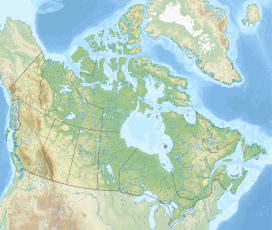Mount Currie is a 2,770-metre (9,090-foot) mountain summit located in the upper Spray River Valley of southern Banff National Park, in the Canadian Rockies of Alberta, Canada.[4] Mount Currie's nearest higher peak is Red Man Mountain, 3.3 km (2.1 mi) to the southwest on the Continental Divide.[1]
| Mount Currie | |
|---|---|
| Highest point | |
| Elevation | 2,770 m (9,090 ft)[1] |
| Prominence | 429 m (1,407 ft)[1] |
| Parent peak | Red Man Mountain (2891 m)[1] |
| Listing | Mountains of Alberta |
| Coordinates | 50°48′11″N 115°29′32″W / 50.80306°N 115.49222°W[2] |
| Geography | |
| Country | Canada |
| Province | Alberta |
| Protected area | Banff National Park |
| Parent range | Blue Range[1] Canadian Rockies |
| Topo map | NTS 82J14 Spray Lakes Reservoir[2] |
| Geology | |
| Rock age | Cambrian |
| Rock type | Sedimentary rock |
| Climbing | |
| First ascent | 1916 by Interprovincial Boundary Commission[3] |
History
editMount Currie was named in 1918 for General Sir Arthur William Currie (1875–1933), the first Canadian commander of the Canadian Corps and later the Canadian Army during World War I.[5][3]
The mountain's name was made official in 1924 by the Geographical Names Board of Canada.[2]
Geology
editMount Currie is composed of sedimentary rock laid down during the Precambrian to Jurassic periods and was later pushed east and over the top of younger rock during the Laramide orogeny.[6] The southeast face of the mountain displays chevron folds in the calcareous shale.[3]
Climate
editBased on the Köppen climate classification, Mount Currie is located in a subarctic climate with cold, snowy winters, and mild summers.[7] Temperatures can drop below −20 °C. with wind chill factors below −30 °C. In terms of favourable weather, June through September are the best months to climb.
Precipitation runoff from the mountain drains into Currie Creek and White Man Creek, which are both tributaries of the Spray River.
See also
editReferences
edit- ^ a b c d e "Mount Currie". Bivouac.com. Retrieved 2018-12-30.
- ^ a b c "Mount Currie". Geographical Names Data Base. Natural Resources Canada. Retrieved 2018-12-28.
- ^ a b c "Mount Currie". cdnrockiesdatabases.ca. Retrieved 2019-11-03.
- ^ "Mount Currie". Geographical Names Data Base. Natural Resources Canada.
- ^ Place-names of Alberta. Ottawa: Geographic Board of Canada. 1928. p. 40.
- ^ Gadd, Ben (2008), Geology of the Rocky Mountains and Columbias
- ^ Peel, M. C.; Finlayson, B. L. & McMahon, T. A. (2007). "Updated world map of the Köppen−Geiger climate classification". Hydrol. Earth Syst. Sci. 11: 1633–1644. ISSN 1027-5606.
External links
edit- National Park Service web site: Banff National Park

